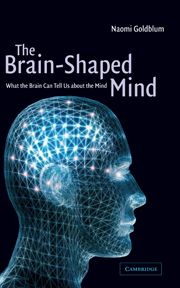Book contents
- Frontmatter
- Contents
- Preface
- Figure permissions and acknowledgments
- 1 Introduction
- 2 What the brain cannot tell us about the mind
- 3 How neurons form networks
- 4 Theories and models of how the mind functions
- 5 What are connectionist networks?
- 6 How our networks learn
- 7 Connecting the networks: how different things are related
- 8 Evidence for connectionist models
- 9 Two different types of memory
- 10 Coping with disaster
- 11 Practical implications
- 12 Criticism of connectionist theory
- Annotated references and suggested readings
- Index
1 - Introduction
Published online by Cambridge University Press: 02 December 2009
- Frontmatter
- Contents
- Preface
- Figure permissions and acknowledgments
- 1 Introduction
- 2 What the brain cannot tell us about the mind
- 3 How neurons form networks
- 4 Theories and models of how the mind functions
- 5 What are connectionist networks?
- 6 How our networks learn
- 7 Connecting the networks: how different things are related
- 8 Evidence for connectionist models
- 9 Two different types of memory
- 10 Coping with disaster
- 11 Practical implications
- 12 Criticism of connectionist theory
- Annotated references and suggested readings
- Index
Summary
How is the brain related to the mind? Do our minds work like computers? Can science's new knowledge about the brain tell us anything of importance about the way our minds work? How can a three-pound mass of tiny jelly-like blobs connected by vast numbers of microscopic filaments be the basis of all our thoughts, feelings, memories, hopes, intentions, knowledge? Will all the new knowledge scientists are gaining about our brains enable them to read our minds with electronic devices?
There is a new way of thinking about the mind and the brain which takes it for granted that the human mind is inseparable from the human body. Since the evidence indicates that the center of our mental activities is the brain, the advocates of this approach try to understand the functioning of the mind on the basis of what we know about the functioning of the brain. This new scientific paradigm has led to the construction of new theories and models of the mind which are variously known as connectionist theories, or neural network models, or theories of parallel distributed processing (PDP). Although some of the ideas on which these new theories are based have been around for over a century, the detailed working out of these models began only in the 1970s.
These new ideas are called connectionist theories because they claim that our mental processes and capacities – how we perceive what is out there in the world, how our knowledge about these things is organized, how we combine all this information to draw new conclusions, how we decide what to do next in order to get what we want – can be explained on the basis of what is known about the multiple interconnections between the neurons, or nerve cells, in the brain.
- Type
- Chapter
- Information
- The Brain-Shaped MindWhat the Brain Can Tell Us About the Mind, pp. 1 - 11Publisher: Cambridge University PressPrint publication year: 2001



